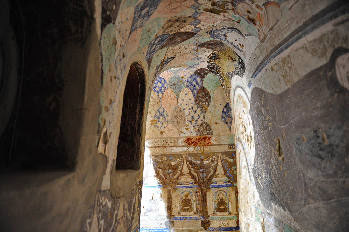 |
|
The rear cell of a grotto with columns in the center. |
In 1985, the Institute of Kucha Caves Research was established in Xinjiang to carry out protection projects organized by the Chinese government and UNESCO. The institute looks after grottoes in the region and repairs those sites. Their efforts have saved murals and cultural relics from decaying.
Since the 1950s, Chinese researchers have been working hard to copy the frescoes. The reproductions stored in the Institute of Kucha Caves Research were mainly painted with water colors and gouache, which cannot be preserved permanently. In 2009, researchers at the institute adopted mineral pigments that are exactly the same as those that were used thousands of years ago. The blue comes from lapis lazuli, and red is extracted from cinnabar and lead tetroxide. The green is mainly made of dioptase. Paintings copied using these pigments have created an ideal effect.
Some murals have suffered under the elements, as well as human activities. In November 2009, the Institute of Kucha Caves Research cooperated with the Chinese Academy of Cultural Heritage to set up plans to revive conservation of the Kizil grottoes. Fourteen caves whose murals had suffered the worst decay were chosen for the first phase of the conservation program. Launched in June 2012, this project combines traditional and up-to-date technologies to protect the frescoes, adhering to the principle of “stressing preservation, rescue first.